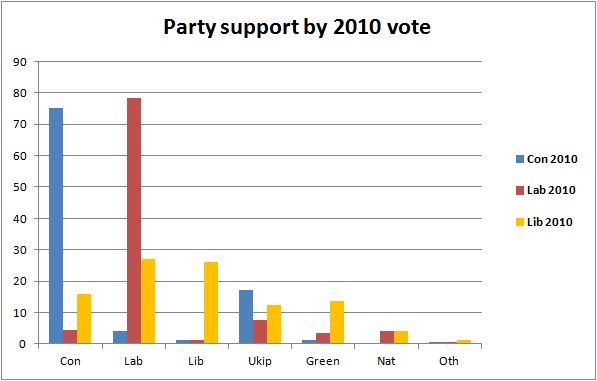The Green party has gained support strongly in recent months. At the last general election only about one voter in a hundred chose them, but pollsters now show their support has grown to 6%. Some Conservative strategists seem to be pleased by this trend. They see the Greens as a "red UKIP" which can take support and attention away from Labour on the left-of-centre. This would counterbalance the loss of Conservative votes to UKIP, according to this Green-friendly theory.
This belief was strong enough for the Conservatives to demand that the Greens participate in the televised Leaders debates. If the Greens' leader Natalie Bennett attends, so the idea runs, then Ed Miliband could be challenged from another direction and Labour would bleed away some votes.

But is this strategy right? Who are the likely Green voters and which parties have they switched their support away from? To find out, it's worth a close look at the details buried in some recent YouGov polls. As well as the headline party support figures, YouGov also breaks current party support down by the respondent's vote at the last general election. We can use this to discover the political background of Green supporters. I added up six separate YouGov polls to get a good sample size of about ten thousand people.
For each major party at the last general election, the chart shows where their voters have gone now. Blue bars represent Conservative voters in 2010, with red for Labour voters and yellow for Liberal Democrat voters. They are grouped together on the horizontal axis by the party which they are currently supporting. Predictably, many voters stick with their previous party: 75% of Conservative voters intend to vote Conservative, and 78% of Labour voters say they will vote Labour next time.
But Liberal Democrat voters are different. Only a quarter of them have stuck with the party, and the rest have spread out to the other parties. Indeed, UKIP has attracted more Lib Dem voters than ex-Labour ones. And many Lib Dem voters have defected to the Greens, but only a handful of Labour voters have done the same thing. The Green supporters are overwhelmingly former Lib Dems.
In electoral terms, this is bad news for the Liberal Democrats rather than for Labour. The Electoral Calculus prediction model, using these YouGov party transition parameters, calculates the effect of the Lib Dems fall and the Greens' rise.
We assume that for every 100 voters that defect from the Lib Dems, 23 voters go to the Conservatives, 39 to Labour, 17 to UKIP and 20 to the Greens.
So although both the Conservatives and Labour benefit from the Lib Dem decline, Labour enjoys a small relative advantage from it. But for the two coalition parties together it is unambiguously bad news.
In addition to the YouGov data above, the article was based on some scenario runs of the Electoral Calculus model. We made a number of scenarios, based on different outcomes for the Liberal Democrats ranging from 1% support (very weak) to 30% (quite strong). Votes were given to and from the Lib Dems and the other parties according to the YouGov transition data above. Namely each 100 Lib Dem voters transfer into/away from: 23 Conservative voters, 39 Labour, 17 UKIP and 20 Green voters.
| Lib % | Con % | Lab % | Ukip % | Green % | CON seats | LAB seats | LIB seats | UKIP seats | Green seats | NAT seats | MIN seats |
|---|---|---|---|---|---|---|---|---|---|---|---|
| 1 | 34 | 36 | 17 | 7 | 271 | 305 | 0 | 11 | 1 | 43 | 18 |
| 5 | 33 | 34 | 16 | 7 | 272 | 302 | 7 | 4 | 1 | 46 | 19 |
| 10 | 32 | 32 | 15 | 6 | 263 | 295 | 24 | 2 | 1 | 47 | 19 |
| 15 | 30 | 30 | 14 | 5 | 255 | 286 | 39 | 2 | 1 | 48 | 19 |
| 20 | 29 | 28 | 14 | 4 | 244 | 273 | 61 | 2 | 1 | 50 | 19 |
| 25 | 28 | 26 | 13 | 3 | 230 | 252 | 96 | 2 | 1 | 51 | 19 |
| 30 | 27 | 24 | 12 | 2 | 204 | 218 | 155 | 1 | 1 | 51 | 19 |
As the table shows, the decline of the Liberal Democrats leads to more votes and seats for the other parties (other than the SNP, who are not deemed to benefit). But on the whole, Labour gains the most: it gains about 11 seats for every 5% reduction in the Lib Dem votes. The Conservatives gain too, but only about 8 seats for every 5%. So Labour relatively gains more from the decline of the Lib Dems and the rise of the Greens.